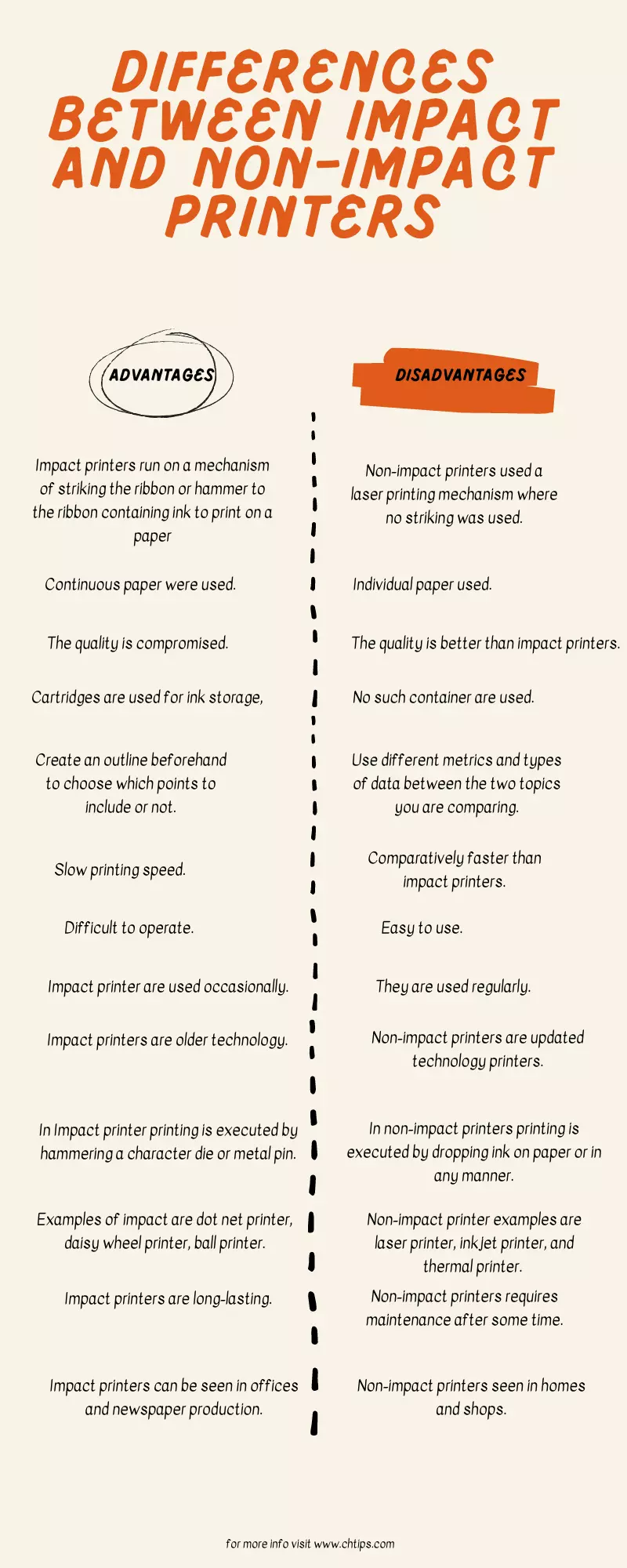
The first computer printer was designed and developed by Charles Babbage . It was a mechanical device for various engines in the 19th century.
However, the design of the mechanical printer was not made until 2000.
In today’s post, we are going to learn and discuss what are the differences between impact and non-impact printers.
Table of Contents
A printer is an output device of a computer system that receives text and graphics from the computer and transfers the information into paper in the form of output.
It is of standard size. Printers are different in size, speed, and cost.
Expensive printers are used when there is a need for constant printing or high-resolution printing. Modern printers are used for high-volume or high-resolution color printing.
It recreates a digital image by spraying ink onto the paper. These printers are the most common type of personal-used printers.
are used to create high-quality prints without defining an image by passing a high laser beam through a negatively charged cylinder.
The color laser printer is often found in professional environments.
It is a new printer technology in 3D printing a digital object from a digital file. This is completed by adding layers to the printing device, and the entire object is ready.
Thermal printing is a digital process that produces printed images without passing through paper with a thermochromic layer.
This paper is commonly known as thermal paper.
This paper is situated on the head of the printer and consists of tiny electrically heated elements.
It is also known as a multifunction printer capable of performing different tasks like printing, copying, scanning, and faxing.
LED printers: It is also known as laser printers.
Instead of the laser used in laser printers, it is used as a light-emitting diode as a light source for print heads.
Similar to an inkjet printer, but explicitly designed to print high-quality photos and requires large amounts of ink and special paper to avoid leaving marks on the ink.
An impact printer is a type that works by direct contact with an ink ribbon with the paper.
A metal or plastic head strikes the ink ribbon which the ribbon is pressed against the paper, and the desired character impression is printed on the sheet.
An impact printer that prints with a fixed number of pins or cables. Pins or wires are placed in one or more vertical columns.
The pen hits the ink-covered ribbon, forcing the ribbon and paper into contact. Each pen then forms a small dot on the paper.
This is a type of impact printer or typewriter in which the character set is mounted on a small metal ball and the font can be changed by easily changing the ball.
This is a particular type of mechanical impact printer. It is used individual letters, symbols, and number keys to print text on paper.
This printer was popular in the 1970s, and this electric typewriter became very popular for its speed and quality, but nowadays, it is rarely being used.
Non-impact printers print text and graphics on paper without hitting it and do not use ink or other substances.
Some of these printers use spray ink while using heat and pressure to create images. These printers are faster than impact printers.
A computer-connected printer that uses a laser to form electrostatically charged spots on a photosensitive drum and attract toner (or dry ink powder) to produce high-quality printing material.
The toner is transferred to a piece of paper and glued by a heating process.
As the paper passes through the print head, the nozzles spray ink to form letters and graphics.
Inkjet printers are computer peripherals that spray the ink onto paper. In inkjet printers, the print head consists of several small nozzles, also called jets.
An image is printed on paper by placing a piece of paper with a thermochromic layer on a print head composed of electrically heated elements and creating an image in the area where the heated layer turns black.
Generate. Sublimation printers are a type of thermal printing technology that uses heat to transfer dye to a material.

People Are Also Reading
I have also written and compiled some articles on computers and telecommunications, and please go through them.
I hope you will like reading it.
I hope that all the questions and queries related to 10 Differences Between Impact and Non-Impact Printers have been answered here.
Don’t hesitate to contact me, and if you need to add, remove, or update anything from the article, please let me know in the comment section or via email.
I will be more than happy to update the article. I am always ready to correct myself.
I was hoping you could share this article with your friends and colleagues; this motivates me to write more on related topics.
. Thank You .